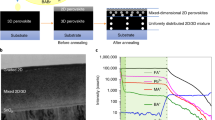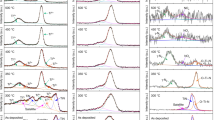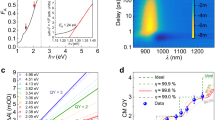Abstract
Metal halide perovskite solar cells (PSCs) are an emerging photovoltaic technology with the potential to disrupt the mature silicon solar cell market. Great improvements in device performance over the past few years, thanks to the development of fabrication protocols1,2,3, chemical compositions4,5 and phase stabilization methods6,7,8,9,10, have made PSCs one of the most efficient and low-cost solution-processable photovoltaic technologies. However, the light-harvesting performance of these devices is still limited by excessive charge carrier recombination. Despite much effort, the performance of the best-performing PSCs is capped by relatively low fill factors and high open-circuit voltage deficits (the radiative open-circuit voltage limit minus the high open-circuit voltage)11. Improvements in charge carrier management, which is closely tied to the fill factor and the open-circuit voltage, thus provide a path towards increasing the device performance of PSCs, and reaching their theoretical efficiency limit12. Here we report a holistic approach to improving the performance of PSCs through enhanced charge carrier management. First, we develop an electron transport layer with an ideal film coverage, thickness and composition by tuning the chemical bath deposition of tin dioxide (SnO2). Second, we decouple the passivation strategy between the bulk and the interface, leading to improved properties, while minimizing the bandgap penalty. In forward bias, our devices exhibit an electroluminescence external quantum efficiency of up to 17.2 per cent and an electroluminescence energy conversion efficiency of up to 21.6 per cent. As solar cells, they achieve a certified power conversion efficiency of 25.2 per cent, corresponding to 80.5 per cent of the thermodynamic limit of its bandgap.
This is a preview of subscription content, access via your institution
Access options
Access Nature and 54 other Nature Portfolio journals
Get Nature+, our best-value online-access subscription
$29.99 / 30 days
cancel any time
Subscribe to this journal
Receive 51 print issues and online access
$199.00 per year
only $3.90 per issue
Buy this article
- Purchase on Springer Link
- Instant access to full article PDF
Prices may be subject to local taxes which are calculated during checkout




Similar content being viewed by others
Data availability
The data that support the findings of this study are available from the corresponding authors upon reasonable request.
Code availability
The LabView codes used in this work are available from the corresponding authors upon reasonable request.
References
Burschka, J. et al. Sequential deposition as a route to high-performance perovskite-sensitized solar cells. Nature 499, 316–319 (2013).
Jeon, N. J. et al. Solvent engineering for high-performance inorganic-organic hybrid perovskite solar cells. Nat. Mater. 13, 897–903 (2014).
Yang, W. S. et al. Iodide management in formamidinium-lead-halide-based perovskite layers for efficient solar cells. Science 356, 1376–1379 (2017).
Jeon, N. J. et al. Compositional engineering of perovskite materials for high-performance solar cells. Nature 517, 476–480 (2015).
Abdi-Jalebi, M. et al. Maximizing and stabilizing luminescence from halide perovskites with potassium passivation. Nature 555, 497–501 (2018).
Saliba, M. et al. Incorporation of rubidium cations into perovskite solar cells improves photovoltaic performance. Science 354, 206–209 (2016).
Wang, Y. et al. Stabilizing heterostructures of soft perovskite semiconductors. Science 365, 687–691 (2019).
Yoo, J. J. et al. An interface stabilized perovskite solar cell with high stabilized efficiency and low voltage loss. Energy Environ. Sci. 12, 2192–2199 (2019).
Min, H. et al. Efficient, stable solar cells by using inherent bandgap of α-phase formamidinium lead iodide. Science 366, 749–753 (2019).
Jung, E. H. et al. Efficient, stable and scalable perovskite solar cells using poly(3-hexylthiophene). Nature 567, 511–515 (2019).
Krückemeier, L., Rau, U., Stolterfoht, M. & Kirchartz, T. How to report record open‐circuit voltages in lead‐halide perovskite solar cells. Adv. Energy Mater. 10, 1902573 (2020).
Shockley, W. & Queisser, H. J. Detailed balance limit of efficiency of p−n junction solar cells. J. Appl. Phys. 32, 510–519 (1961).
Jung, K. H., Seo, J. Y., Lee, S., Shin, H. & Park, N. G. Solution-processed SnO2 thin film for a hysteresis-free planar perovskite solar cell with a power conversion efficiency of 19.2%. J. Mater. Chem. A 5, 24790–24803 (2017).
Shi, S. et al. Room-temperature synthesized SnO2 electron transport layers for efficient perovskite solar cells. RSC Adv. 9, 9946–9950 (2019).
Li, J. et al. Enhanced crystallinity of low-temperature solution-processed SnO2 for highly reproducible planar perovskite solar cells. ChemSusChem 11, 2898–2903 (2018).
Jeong, S., Seo, S., Park, H. & Shin, H. Atomic layer deposition of a SnO2 electron-transporting layer for planar perovskite solar cells with a power conversion efficiency of 18.3. Chem. Commun. 55, 2433–2436 (2019).
Kam, M., Zhang, Q., Zhang, D. & Fan, Z. Room-temperature sputtered SnO2 as robust electron transport layer for air-stable and efficient perovskite solar cells on rigid and flexible substrates. Sci. Rep. 9, 6963 (2019).
Yun, A. J., Kim, J., Hwang, T. & Park, B. Origins of efficient perovskite solar cells with low-temperature processed SnO2 electron transport layer. ACS Appl. Energy Mater. 2, 3554–3560 (2019).
Jiang, Q. et al. Surface passivation of perovskite film for efficient solar cells. Nat. Photon. 13, 460–466 (2019).
Rau, U. Reciprocity relation between photovoltaic quantum efficiency and electroluminescent emission of solar cells. Phys. Rev. B 76, 085303 (2007).
Stolterfoht, M. et al. Voltage-dependent photoluminescence and how it correlates with the fill factor and open-circuit voltage in perovskite solar cells. ACS Energy Lett. 4, 2887–2892 (2019).
Halvani Anaraki, E. et al. Low-temperature Nb-doped SnO2 electron-selective contact yields over 20% efficiency in planar perovskite solar cells. ACS Energy Lett. 3, 773–778 (2018).
Correa Baena, J. P. et al. Highly efficient planar perovskite solar cells through band alignment engineering. Energy Environ. Sci. 8, 2928–2934 (2015).
Uchiyama, H., Ohgi, H. & Imai, H. Selective preparation of SnO2 and SnO crystals with controlled morphologies in an aqueous solution system. Cryst. Growth Design 6, 2186–2190 (2006).
Ibarguen, C. A., Mosquera, A., Parra, R., Castro, M. S. & Rodríguez-Páez, J. E. Synthesis of SnO2 nanoparticles through the controlled precipitation route. Mater. Chem. Phys. 101, 433–440 (2007).
Ghosh, S. & Roy, S. Effect of ageing on Sn6O4(OH)4 in aqueous medium—simultaneous production of SnO and SnO2 nanoparticles at room temperature. J. Sol-Gel Sci. Technol. 81, 769–773 (2017).
Wang, J. et al. Controlled synthesis of Sn-based oxides: via a hydrothermal method and their visible light photocatalytic performances. RSC Adv. 7, 27024–27032 (2017).
Wang, H. et al. Engineering of facets, band structure, and gas-sensing properties of hierarchical Sn2+-doped SnO2 nanostructures. Adv. Funct. Mater. 23, 4847–4853 (2013).
Han, D., Jiang, B., Feng, J., Yin, Y. & Wang, W. Photocatalytic self-doped SnO2-x nanocrystals drive visible-light-responsive color switching. Angew. Chem. Int. Ed. 56, 7792–7796 (2017).
Fan, C. M. et al. Synproportionation reaction for the fabrication of Sn2+ self-doped SnO2-x nanocrystals with tunable band structure and highly efficient visible light photocatalytic activity. J. Phys. Chem. C 117, 24157–24166 (2013).
Cohen, R. L. & West, K. W. Solution chemistry and colloid formation in the chloride sensitizing process. J. Electrochem. Soc. 119, 433–438 (1972).
Matsuno, H., Kawashima, Y. & Serizawa, T. Peptide-induced formation of crystalline Sn6O4(OH)4 nanoparticles under ambient conditions. Bull. Chem. Soc. Jpn 85, 746–752 (2012).
Ning, J. et al. Facile synthesis of tin oxide nanoflowers: a potential high-capacity lithium-ion-storage material. Langmuir 25, 1818–1821 (2009).
Li, N. et al. Effects of oxygen vacancies on the electrochemical performance of tin oxide. J. Mater. Chem. A 1, 1536–1539 (2013).
Yang, Y., Wang, Y. & Yin, S. Oxygen vacancies confined in SnO2 nanoparticles for desirable electronic structure and enhanced visible light photocatalytic activity. Appl. Surf. Sci. 420, 399–406 (2017).
Sun, M., Su, Y., Du, C., Zhao, Q. & Liu, Z. Self-doping for visible light photocatalytic purposes: construction of SiO2/SnO2/SnO2:Sn2+ nanostructures with tunable optical and photocatalytic performance. RSC Adv. 4, 30820–30827 (2014).
Wang, J. et al. Performance enhancement of perovskite solar cells with Mg-doped TiO2 compact film as the hole-blocking layer. Appl. Phys. Lett. 106, 121104 (2015).
Zhou, Y. et al. Manipulating crystallization of organolead mixed-halide thin films in antisolvent baths for wide-bandgap perovskite solar cells. ACS Appl. Mater. Interf. 8, 2232–2237 (2016).
Kim, S., Eom, T., Ha, Y.-S., Hong, K.-H. & Kim, H. Thermodynamics of multicomponent perovskites: a guide to highly efficient and stable solar cell materials. Chem. Mater. 32, 4265–4272 (2020).
Jeon, J. et al. Polymorphic phase control mechanism of organic–inorganic hybrid perovskite engineered by dual-site alloying. J. Phys. Chem. C 121, 9508–9515 (2017).
Liu, Y. et al. Ultrahydrophobic 3D/2D fluoroarene bilayer-based water-resistant perovskite solar cells with efficiencies exceeding 22. Sci. Adv. 5, eaaw2543 (2019).
Correa-Baena, J.-P. et al. Homogenized halides and alkali cation segregation in alloyed organic-inorganic perovskites. Science 363, 627–631 (2019).
Rehman, W. et al. Charge-carrier dynamics and mobilities in formamidinium lead mixed-halide perovskites. Adv. Mater. 27, 7938–7944 (2015).
Kim, D. H. et al. 300% enhancement of carrier mobility in uniaxial-oriented perovskite films formed by topotactic-oriented attachment. Adv. Mater. 29, 1606831 (2017).
National Renewable Energy Laboratory Best Research-Cell Efficiencies https://www.nrel.gov/pv/assets/pdfs/best-research-cell-efficiencies.20191106.pdf (NREL, 2019).
Guillemoles, J. F., Kirchartz, T., Cahen, D. & Rau, U. Guide for the perplexed to the Shockley–Queisser model for solar cells. Nat. Photon. 13, 501–505 (2019).
Kiermasch, D., Gil-Escrig, L., Bolink, H. J. & Tvingstedt, K. Effects of masking on open-circuit voltage and fill factor in solar cells. Joule 3, 16–26 (2019).
Lin, K. et al. Perovskite light-emitting diodes with external quantum efficiency exceeding 20 per cent. Nature 562, 245–248 (2018).
Cao, Y. et al. Perovskite light-emitting diodes based on spontaneously formed submicrometre-scale structures. Nature 562, 249–253 (2018).
Chiba, T. et al. Anion-exchange red perovskite quantum dots with ammonium iodine salts for highly efficient light-emitting devices. Nat. Photon. 12, 681–687 (2018).
Acknowledgements
J.J.Y. was funded by the Institute for Soldier Nanotechnology (ISN) grant W911NF-13-D-0001 and the National Aeronautics and Space Administration (NASA) grant NNX16AM70H. Y.L. and M.G.B. were funded by Eni SpA through the MIT Energy Initiative. M.R.C. was funded by the Agency for Science Technology and Research, Singapore. V.B. was funded by Tata Trusts. T.G.P. and F.R. were funded by the National Research Foundation of Korea (NRF-2019R1A2C3003504) and a National Research Council of Science & Technology (NST) grant from the Korean government (MSIT) (grant number CAP-18-05-KAERI). G.S., S.S.S., C.S.M., N.J.J. and J.S. were supported by a grant from the Korea Research Institute of Chemical Technology (KRICT), South Korea (KS2022-10); the Korea Institute of Energy Technology Evaluation and Planning (KETEP) and the Ministry of Trade Industry & Energy (MOTIE) of South Korea (grant number 20183010014470); by a grant from the National Research Foundation of Korea (NRF) funded by the Ministry of Science, ICT & Future Planning (MSIP) of South Korea (NRF-2016M3A6A7945503) and by a grant from the NST from the Korean government (MSIT) (grant number CAP-18-05-KAERI). We thank S.-M. Bang, G. Kim, K. Kim, J. Kim and J. Park for discussions and assistance with the experiments. We thank KARA (KAIST Analysis center for Research Advancement) for their assistance with X-ray photoelectron spectroscopy and ultraviolet photoelectron spectroscopy measurements and analysis.
Author information
Authors and Affiliations
Contributions
J.J.Y., G.S. and S.S.S. conceived and designed the experiment. G.S. and S.S.S. conducted the synthesis and the analysis of the SnO2 film along with J.-P.C.-B. J.J.Y. and Y.L. performed the characterization of the perovskite films. J.J.Y., G.S. and S.S.S. conducted the fabrication of perovskite solar cells and their certification. Y.-K.K. conducted the TEM analysis. M.R.C. conducted the electroluminescence measurements with supervision from V.B. C.S.M. conducted the transient photovoltage and transient photocurrent measurements. T.G.P. performed the optical pump−terahertz probe measurements with supervision from F.R. J.J.Y. and G.S. wrote the first draft of the manuscript and all authors contributed feedback and comments. N.J.J. synthesized materials for perovskite film. S.S.S., M.G.B. and J.S. directed and supervised the research.
Corresponding authors
Ethics declarations
Competing interests
The authors declare no competing interests.
Additional information
Peer review information Nature thanks the anonymous reviewer(s) for their contribution to the peer review of this work.
Publisher’s note Springer Nature remains neutral with regard to jurisdictional claims in published maps and institutional affiliations.
Supplementary information
Supplementary Information
This file contains Supplementary Methods, Supplementary Figures 1-26 and Supplementary References.
Rights and permissions
About this article
Cite this article
Yoo, J.J., Seo, G., Chua, M.R. et al. Efficient perovskite solar cells via improved carrier management. Nature 590, 587–593 (2021). https://doi.org/10.1038/s41586-021-03285-w
Received:
Accepted:
Published:
Issue Date:
DOI: https://doi.org/10.1038/s41586-021-03285-w
This article is cited by
-
Efficient and stable perovskite solar cells with regulated depletion region
Nature Photonics (2024)
-
All-perovskite-based unassisted photoelectrochemical water splitting system for efficient, stable and scalable solar hydrogen production
Nature Energy (2024)
-
Multifunctional sulfonium-based treatment for perovskite solar cells with less than 1% efficiency loss over 4,500-h operational stability tests
Nature Energy (2024)
-
Toward stabilization of formamidinium lead iodide perovskites by defect control and composition engineering
Nature Communications (2024)
-
Completely annealing-free flexible Perovskite quantum dot solar cells employing UV-sintered Ga-doped SnO2 electron transport layers
npj Flexible Electronics (2024)
Comments
By submitting a comment you agree to abide by our Terms and Community Guidelines. If you find something abusive or that does not comply with our terms or guidelines please flag it as inappropriate.



